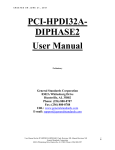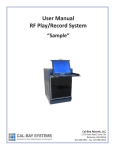Download SIS3302 100 MHz 16-bit VME Digitizer User Manual
Transcript
SIS Documentation SIS3302 100 MHz 16-bit Digitizer SIS3302 100 MHz 16-bit VME Digitizer User Manual SIS GmbH Harksheider Str. 102A 22399 Hamburg Germany Phone: ++49 (0) 40 60 87 305 0 Fax: ++49 (0) 40 60 87 305 20 email: [email protected] http://www.struck.de Version: sis3302-M-010E-001-v109 as of 10.07.09 Page 1 of 61 SIS Documentation SIS3302 100 MHz 16-bit Digitizer Revision Table: Revision 0.01 0.04 0.05 0.06 1.00 1.01 1.02 1.03 Date 18.03.06 08.06.06 13.06.06 16.06.06 23.06.06 03.07.07 18.10.07 04.02.08 1.04 14.02.08 1.05 01.07.08 1.06 1.07 1.08 17.08.08 24.11.08 10.12.08 1.09 10.07.09 Page 2 of 61 Modification Generation from SIS3320 Th MKI workup Definition of airflow First official release Bug fixes in interrupt control register DAC load sequence diagram Design Version: 010B New Features: - Average Mode (2,4,8, …, 128) - 48-bit Timestamp - Leading edge trigger Design Version: 010C Bug fix: odd VME IRQs Design Version: 010D New clock source: Second internal 100 MHz Firmware comment for 2nd internal 100 MHz Bug fix in sample length register description Design Version: 010E New Features: - ADC value order programmable (little/big endian) Bug fix in broadcast setup SIS Documentation SIS3302 100 MHz 16-bit Digitizer - Table of contents 1 Table of contents..............................................................................................................3 Introduction .....................................................................................................................5 1.1 2 Related documents............................................................................................................................. 5 Technical Properties/Features...........................................................................................6 2.1 Key functionality............................................................................................................................... 6 2.2 Module design................................................................................................................................... 7 2.2.1 Dual channel group .................................................................................................................... 8 2.3 Modes of Operation ........................................................................................................................... 8 2.4 Memory management ........................................................................................................................ 8 2.4.1 Single Event Mode..................................................................................................................... 8 2.4.2 Multi Event Mode...................................................................................................................... 8 2.5 Clock sources .................................................................................................................................... 9 2.5.1 Internal clock ............................................................................................................................. 9 2.5.2 External clock ............................................................................................................................ 9 2.6 Trigger control (pre/post, start/stop mode).......................................................................................... 9 2.7 Internal Trigger generation............................................................................................................... 10 2.8 VME Interrupts ............................................................................................................................... 10 3 VME Addressing ...........................................................................................................11 3.1 4 Address Map ................................................................................................................................... 12 Register Description.......................................................................................................14 4.1 Control/Status Register(0x, write/read)............................................................................................. 14 4.2 Module Id. and Firmware Revision Register (0x4, read) ................................................................... 15 4.2.1 Major revision numbers............................................................................................................ 15 4.3 Interrupt configuration register (0x8) ............................................................................................... 16 4.3.1 IRQ mode ................................................................................................................................ 16 4.4 Interrupt control register (0xC)......................................................................................................... 17 4.5 Acquisition control register (0x10, read/write).................................................................................. 19 4.6 Start Delay register (0x14, read/write).............................................................................................. 21 4.7 Stop Delay register (0x18, read/write) .............................................................................................. 21 4.8 Max_Nof_Events_Register (0x20, read/write).................................................................................. 22 4.9 Actual_Event_Counter (0x24, read) ................................................................................................ 22 4.10 CBLT/Broadcast setup register ........................................................................................................ 23 4.11 ADC Memory Page register............................................................................................................. 24 4.12 DAC Control Registers.................................................................................................................... 25 4.12.1 DAC Control/Status register (read/write) .................................................................................. 25 4.12.2 DAC Data register (read/write)................................................................................................ 26 4.12.3 DAC load sequence (read/write).............................................................................................. 26 4.13 Key address general reset................................................................................................................. 28 4.14 Key address VME arm sampling logic ............................................................................................. 28 4.15 Key address VME disarm sampling logic......................................................................................... 28 4.16 Key address VME start sampling ..................................................................................................... 28 4.17 Key address VME stop sampling ..................................................................................................... 28 4.18 Key address Timestamp Clear (0x42C) ............................................................................................ 28 4.19 Event Timestamp directory .............................................................................................................. 29 4.20 Event configuration registers............................................................................................................ 30 4.20.1 Averaging mode....................................................................................................................... 31 4.20.2 Wrap Page size ........................................................................................................................ 32 4.21 Event Length register....................................................................................................................... 33 4.22 Sample Start address register ........................................................................................................... 34 4.22.1 Explanation (sample start address)........................................................................................ 34 4.23 ADC Input mode register................................................................................................................. 35 4.24 ADC1-8 Next Sample address register ............................................................................................. 36 4.25 Actual Sample Value registers ......................................................................................................... 37 4.26 DDR2 Memory Logic Verification registers..................................................................................... 37 4.27 Trigger setup register registers ......................................................................................................... 38 4.28 Threshold registers .......................................................................................................................... 39 Page 3 of 61 SIS Documentation SIS3302 100 MHz 16-bit Digitizer 4.28.1 Leading edge Trigger ............................................................................................................... 39 4.28.2 FIR Trigger.............................................................................................................................. 40 4.29 Trigger Flag Clear Counter register.................................................................................................. 41 4.30 Event directories.............................................................................................................................. 42 4.31 ADC memory .................................................................................................................................. 43 5 Description of Start/Stop modes of operation .................................................................44 5.1 5.2 6 7 Start logic summary......................................................................................................................... 44 Stop logic summary ......................................................................................................................... 45 Board layout ..................................................................................................................46 Front panel.....................................................................................................................47 7.1 7.2 7.3 7.4 8 Control In/Outputs........................................................................................................................... 48 LED's .............................................................................................................................................. 49 Channel LED's ................................................................................................................................ 49 PCB LEDs....................................................................................................................................... 49 Jumpers/Configuration ...................................................................................................50 8.1 8.2 8.3 8.4 8.5 8.6 CON100 JTAG................................................................................................................................ 50 JP80 VME addressing mode/reset behaviour .................................................................................... 50 JP101 JTAG chain........................................................................................................................... 51 JP102 JTAG source ......................................................................................................................... 52 JP120A-JP120D control input termination ....................................................................................... 53 SW1 and SW2, VME base address................................................................................................... 53 9 Getting started................................................................................................................54 10 Appendix ....................................................................................................................55 10.1 Power consumption ......................................................................................................................... 55 10.2 Operating conditions........................................................................................................................ 55 10.2.1 Cooling.................................................................................................................................... 55 10.2.2 Hot swap/live insertion............................................................................................................. 55 10.3 Connector types............................................................................................................................... 56 10.4 P2 row A/C pin assignments ............................................................................................................ 56 10.5 Row d and z Pin Assignments.......................................................................................................... 57 10.6 Firmware upgrade............................................................................................................................ 58 10.6.1 Upgrade over CON100............................................................................................................. 58 10.6.2 Upgrade over VME.................................................................................................................. 58 11 Index ..........................................................................................................................59 Page 4 of 61 SIS Documentation 1 SIS3302 100 MHz 16-bit Digitizer Introduction The SIS3302 is an eight channel ADC/digitizer board with a sampling rate of up to 100 MHz (for the individual channel) and a resolution of 16-bit. The board is a single width 6U VME card, which has no special (i.e. non standard VME) voltage requirements. The flexible combination of DDR2 memory technology data storage in combination with FPGA based data handling/movement allows for a generic design which covers a variety of applications. Applications comprise but are not limited to: digitization of “slow” detectors like calorimeters accelerator/machine controls As we are aware, that no manual is perfect, we appreciate your feedback and will try to incorporate proposed changes and corrections as quickly as possible. The most recent version of this manual can be obtained by email from [email protected], the revision dates are online under http://www.struck.de/manuals.htm. 1.1 Related documents A list of available firmware designs can be retrieved from http://www.struck.de/sis3302firm.htm Page 5 of 61 SIS Documentation SIS3302 100 MHz 16-bit Digitizer 2 Technical Properties/Features 2.1 Key functionality Find below a list of key features of the SIS3302 digitizer. 8 channels 16-bit resolution 32 MSamples/channel memory external clock range 1 ... 100 MHz special clock mode (random external clock) external/internal clock input bandwidth 50 MHz offset DACs multi event mode read on the fly (actual sample value) pre/post trigger option readout in parallel to acquisition trigger generation (FIR trigger) 4 NIM control inputs/4 NIM control outputs A32 D32/BLT32/MBLT64/2eVME/2eSST Hot swap (in conjunction with VME64x backplane) VME64x Connectors VME64x Front panel VME64x extractor handles (on request) F1002 compatible P2 row A/C assignment +5 V, +12V and –12 V VME standard voltages LEMO00, SMA or LEMO 0S (differential) analog input connectors default input span of 5V (can be shifted with DAC to accomplish input range settings like +2.5 V, ... –2.5 V e.g.) Note: The SIS3302 shall not be operated on P2 row A/C extensions, like VSB e.g. due to the compatibility to the F1002 FADC modules clock and start/stop distribution scheme. Page 6 of 61 SIS Documentation SIS3302 100 MHz 16-bit Digitizer 2.2 Module design The SIS3302 consists of four identical groups of 2 ADC channels each and a control section as shown in the simplified block diagram below. Page 7 of 61 SIS Documentation SIS3302 100 MHz 16-bit Digitizer 2.2.1 Dual channel group Two ADC channels form a group, which memory is handled by one Field Programmable Gate Array (FPGA). 2.3 Modes of Operation The SIS3302 was developed with maximum flexibility in mind. The FPGA based design of the card allows to meet the requirements of many readout applications with dedicated firmware designs in the future. The initial firmware is supposed to furnish you with an easy to use yet powerful high speed high resolution Flash Analog to Digital Converter (FADC) implementation, that covers many everyday analog to digital applications. 2.4 Memory management The memory can be used either as one contiguous memory or as a subdivided multi event memory. In addition memory depth can be limited in single event operation to match the requirements of the given application. 2.4.1 Single Event Mode The full memory of 32 MSamples of the SIS3302 is used as one big circular buffer or as single shot memory in single event mode, unless memory size is limited by the event configuration register. 2.4.2 Multi Event Mode The memory can be divided in pages or events to make the acquisition of shorter signals more efficient. Up to 512 stop pointers for the individual page can be retrieved from the event directory. In auto start mode the ADC advances to the next page and starts sampling automatically. Page 8 of 61 SIS Documentation SIS3302 100 MHz 16-bit Digitizer 2.5 Clock sources The SIS3302 features the two basic clock modes Internal clock External symmetric clock Random external clock 2.5.1 Internal clock The internal clock is generated from an on board 50 MHz quartz. It is either doubled or prescaled to generate 100 MHz or lower clock speeds respectively. A 100 MHz quartz is available as 2nd internal 100 MHz clock source from firmware revision 0x010D on with the corresponding stuffing option (i.e. U212 stuffed with a 100 MHz 3.3 V oscillator, Struck part number 02954) Internal clock speeds 100 MHz Second 100 MHz (0x010D) 50 MHz 25 MHz 10 MHz 1 MHz For optimum internal clock speed resolution the use of the “Second internal 100 MHz” instead of “internal 100 MHz is recommended. Prerequisites for the availability of the 2nd 100 MHz: 1.) U212 stuffed with a 100 MHz 3.3 V oscillator 2.) Firmware revision 0x010D or higher 2.5.2 External clock A symmetric external clock (NIM level, ratio between 45:55 and 55:45) can be fed to the module through a LEMO00 connector. An ECL clock over rows A/C of the J2 VME backplane is prepared but not implemented. For optimum performance the clock frequency should be within the specified range for the given ADC chip. Module SIS3302-100 Min. sym. clock 1 MHz Max sym. clock 100 MHz Lower sampling speeds are possible in random external clock mode. 2.6 Trigger control (pre/post, start/stop mode) The SIS3302 features pre/post trigger capability as well as start/stop mode . The trigger behaviour is defined by the acquisition control register. Page 9 of 61 SIS Documentation 2.7 SIS3302 100 MHz 16-bit Digitizer Internal Trigger generation The trigger output of the SIS3302 can be either used to interact with external trigger logic or to base start/stop on a threshold (i.e. one individual threshold per ADC channel) of the digitized data. Trigger generation can be activated with two conditions: module armed (i.e. sample clock active, trigger can be used to start acquisition) module armed and started (trigger can be used to stop acquisition) The user can select between triggering on the conditions above and below threshold The trigger is formed with a trapezoidal FIR fiter.. 2.8 VME Interrupts Two registers, the Interrupt configuration and the Interrupt control register, are implemented for interrupt setup and control. Two interrupt sources are implemented: - End of Event - End of Last Event in Multi Event mode Page 10 of 61 SIS Documentation 3 SIS3302 100 MHz 16-bit Digitizer VME Addressing As the SIS3302 VME FADC features memory options with up to 8 times 32 MSamples, A32 addressing was implemented as the only option. The module occupies an address space of 0x7FFFFFF Bytes, i.e. 128 MBytes are used by the module. The base address is defined by the selected addressing mode, which is selected by jumper array JP80 and SW1 and SW2 (in non geographical mode). The table below summarises the possible base address settings. J1 Setting Bits A32 GEO VIPA 31 30 29 28 27 x SW1 SW2=0...7 Bit 27=0 x SW1 SW2=8...F Bit 27=1 x x Not implemented in this design x Shorthand SW1/SW2 Not implemented in this design Explanation Setting of rotary switch SW1 or SW2 respective Notes: This concept allows the use of the SIS3302 in standard VME as well as in VME64x environments, i.e. the user does not need to use a VME64x backplane. The factory default setting is EN_A32 closed, SW1=3, SW2=0 (i.e. the module will react to A32 addressing under address 0x30000000). With more than one unit shipped in one batch a set of addresses (like 0x10000000, 0x20000000, 0x30000000,...) may be used also. Page 11 of 61 SIS Documentation SIS3302 100 MHz 16-bit Digitizer 3.1 Address Map The SIS3302 resources and their locations are listed in the table below. Note: Write access to a key address (KA)with arbitrary data invokes the respective action Offset Size in Bytes BLT Access Function 0x00000000 0x00000004 0x00000008 0x0000000C 4 4 4 4 - W/R R R/W R/W Control/Status Register (J-K register) Module Id. and Firmware Revision register Interrupt configuration register Interrupt control register 0x00000010 0x00000014 0x00000018 4 4 4 - R/W R/W R/W Acquisition control/status register (J-K register) Extern Start Delay register Extern Stop Delay register R/W R Max. Nof Events Register Actual Event Counter 0x00000020 0x00000024 0x00000030 0x00000034 4 4 - R/W R/W CBLT/Broadcast Setup register ADC Memory Page register 0x00000050 0x00000054 4 4 - R/W R/W DAC Control Status register DAC Data register R/W W XILINX JTAG_TEST/JTAG_DATA_IN XILINX JTAG_CONTROL 0x00000060 0x00000064 0x00000400 4 - KA W Key General Reset 0x00000410 0x00000414 0x00000418 0x0000041C 4 4 4 4 - KA W KA W KA W KA W Key Arm Sampling Logic Key Disarm Sampling Logic Key sampling Key Stop sampling 0x0000042C 4 - KA W Key Timestamp Clear 0x00010000 0x1000 D32, BLT32 R Event information all ADC groups 0x01000000 4 0x01000004 4 0x01000008 4 0x0100000C 4 - Page 12 of 61 W only W only W only W only Event Timestamp directory Event configuration register (all ADCs) Event Length register (all ADCs) Sample Start address register (all ADCs) ADC input mode register (all ADCs) SIS Documentation SIS3302 100 MHz 16-bit Digitizer Event information ADC group 1 0x02000000 4 0x02000004 4 0x02000008 4 0x0200000C 4 - R/W R/W R/W R/W Event configuration register (ADC1, ADC2) Event Length register (ADC1, ADC2) Sample Start address register (ADC1, ADC2) ADC input mode register (ADC1, ADC2) 0x02000010 0x02000014 4 4 - R R Next Sample address register ADC1 Next Sample address register ADC2 0x02000020 0x02000024 0x02000028 4 4 4 - R R R Actual Sample Value (ADC1, ADC2) internal Test register DDR2 Memory Logic Veryfication register (ADC1, ADC2) 0x0200002C 4 R/W Trigger Flag Clear Counter register (ADC1, ADC2) 0x02000030 0x02000034 0x02000038 0x0200003C 4 4 4 4 R/W R/W R/W R/W ADC1 Trigger setup register ADC1 Trigger Threshold register ADC2 Trigger setup register ADC2 Trigger Threshold register 0x02010000 0x02018000 0x800 D32, BLT32 0x800 D32, BLT32 R Event directory ADC1 R Event directory ADC2 Event information ADC group 2 0x02800000 4 And so on (as for ADC group 1) - R/W Event configuration register (ADC3, ADC4) Event information ADC group 3 0x03000000 4 And so on (as for ADC group 1) - R/W Event configuration register (ADC5, ADC6) Event information ADC group 4 0x03800000 4 And so on (as for ADC group 1) - R/W Event configuration register (ADC7, ADC8) X X X X X X X X R R R R R R R R ADC memory pages 0x04000000 0x04800000 0x05000000 0x05800000 0x06000000 0x06800000 0x07000000 0x07800000 8 MByte 8 MByte 8 MByte 8 MByte 8 MByte 8 MByte 8 MByte 8 MByte ADC 1 memory page ADC 2 memory page ADC 3 memory page ADC 4 memory page ADC 5 memory page ADC 6 memory page ADC 7 memory page ADC 8 memory page Note 2: MBLT64, 2eVME and 2eSST read access is supported from memory (i.e. not from register space) only. Page 13 of 61 SIS Documentation SIS3302 100 MHz 16-bit Digitizer 4 Register Description The function of the individual registers is described in detail in this section. The first line after the subsection header (in Courier font) like: #define SIS3302_CONTROL_STATUS 0x0 /* read/write; D32 */ refers to the sis3302.h header file. 4.1 Control/Status Register(0x, write/read) #define SIS3302_CONTROL_STATUS 0x0 /* read/write; D32 */ The control register is implemented as a selective J/K register, a specific function is enabled by writing a 1 into the set/enable bit, the function is disabled by writing a 1 into the clear/disable bit (which location is 16-bit higher in the register). An undefined toggle status will result from setting both the enable and disable bits for a specific function at the same time. The only function at this point in time is user LED on/off. On read access the same register represents the status register. Bit 31 30 29 28 27 26 25 24 23 22 21 20 19 18 17 16 15 14 13 12 11 10 9 8 7 6 5 4 3 2 1 0 write Function Clear reserved 15 (*) Clear reserved 14 (*) Clear reserved 13 (*) Clear reserved 12 (*) Clear reserved 11 (*) Clear reserved 10 (*) Clear reserved 9 (*) Clear reserved 8 (*) Clear reserved 7 (*) Clear reserved 6 (*) Clear reserved 5 (*) Clear reserved 4 (*) Clear reserved 3 (*) Clear reserved 2 (*) Clear reserved 1 (*) Switch off user LED (*) Set reserved 15 Set reserved 14 Set reserved 13 Set reserved 12 Set reserved 11 Set reserved 10 Set reserved 9 Set reserved 8 Set reserved 7 Set reserved 7 Set reserved 7 Set reserved 7 Set reserved 3 Set reserved 2 Set reserved 1 Switch on user LED (*) denotes power up default setting Page 14 of 61 read Function 0 0 0 0 0 0 0 0 0 0 0 0 0 0 0 0 Status reserved 15 Status reserved 14 Status reserved 13 Status reserved 12 Status reserved 11 Status reserved 10 Status reserved 9 Status reserved 8 Status reserved 7 Status reserved 6 Status reserved 4 Status reserved 4 Status reserved 3 Status reserved 2 Status reserved 1 Status User LED (1=LED on, 0=LED off) SIS Documentation 4.2 SIS3302 100 MHz 16-bit Digitizer Module Id. and Firmware Revision Register (0x4, read) #define SIS3302_MODID 0x4 /* read only; D32 */ This register reflects the module identification of the SIS3302 and its minor and major firmware revision levels. The major revision level will be used to distinguish between substantial design differences and experiment specific designs, while the minor revision level will be used to mark user specific adaptations. Bit 31 30 29 28 27 26 25 24 23 22 21 20 19 18 17 16 15 14 13 12 11 10 9 8 7 6 5 4 3 2 1 0 Function Module Id. Bit 15 Module Id. Bit 14 Module Id. Bit 13 Module Id. Bit 12 Module Id. Bit 11 Module Id. Bit 10 Module Id. Bit 9 Module Id. Bit 8 Module Id. Bit 7 Module Id. Bit 6 Module Id. Bit 5 Module Id. Bit 4 Module Id. Bit 3 Module Id. Bit 2 Module Id. Bit 1 Module Id. Bit 0 Major Revision Bit 7 Major Revision Bit 6 Major Revision Bit 5 Major Revision Bit 4 Major Revision Bit 3 Major Revision Bit 2 Major Revision Bit 1 Major Revision Bit 0 Minor Revision Bit 7 Minor Revision Bit 6 Minor Revision Bit 5 Minor Revision Bit 4 Minor Revision Bit 3 Minor Revision Bit 2 Minor Revision Bit 1 Minor Revision Bit 0 Reading 3 3 0 2 4.2.1 Major revision numbers Find below a table with major revision numbers used to date Major revision number 0x01 0x20 Application/user Generic designs Gamma design Page 15 of 61 SIS Documentation SIS3302 100 MHz 16-bit Digitizer 4.3 Interrupt configuration register (0x8) #define SIS3302_IRQ_CONFIG 0x8 /* read/write; D32 */ This read/write register controls the VME interrupt behaviour of the SIS3302 ADC. Four interrupt sources are foreseen, for the time being three of them are associated with an interrupt condition, the fourth condition is reserved for future use. The interrupter type is DO8 . 4.3.1 IRQ mode In RORA (release on register access) mode the interrupt will be pending until the IRQ source is cleared by specific access to the corresponding disable VME IRQ source bit. After the interrupt is serviced the source has to be activated with the enable VME IRQ source bit again. In ROAK (release on acknowledge) mode , the interrupt condition will be cleared (and the IRQ source disabled) as soon as the interrupt is acknowledged by the CPU. After the interrupt is serviced the source has to be activated with the enable VME IRQ source bit again. Bit 31 ... 16 15 14 13 12 11 10 9 8 7 6 5 4 3 2 1 0 Function RORA/ROAK Mode (0: RORA; 1: ROAK) VME IRQ Enable (0=IRQ disabled, 1=IRQ enabled) VME IRQ Level Bit 2 VME IRQ Level Bit 1 VME IRQ Level Bit 0 IRQ Vector Bit 7; placed on D7 during VME IRQ ACK cycle IRQ Vector Bit 6; placed on D6 during VME IRQ ACK cycle IRQ Vector Bit 5; placed on D5 during VME IRQ ACK cycle IRQ Vector Bit 4; placed on D4 during VME IRQ ACK cycle IRQ Vector Bit 3; placed on D3 during VME IRQ ACK cycle IRQ Vector Bit 2; placed on D2 during VME IRQ ACK cycle IRQ Vector Bit 1; placed on D1 during VME IRQ ACK cycle IRQ Vector Bit 0; placed on D0 during VME IRQ ACK cycle The power up default value reads 0x 00000000 Page 16 of 61 Default 0 0 0 0 0 0 0 0 0 0 0 0 0 0 0 0 0 0 0 SIS Documentation SIS3302 100 MHz 16-bit Digitizer 4.4 Interrupt control register (0xC) #define SIS3302_IRQ_CONTROL 0xC /* read/write; D32 */ This register controls the VME interrupt behaviour of the SIS3302 ADC. Eight interrupt sources are foreseen, for the time being two of them are associated with an interrupt condition, the others are reserved for future use. Bit 31 30 29 28 27 26 25 Function (w) Update IRQ Pulse unused unused unused unused unused unused 24 23 22 21 20 19 18 17 16 15 14 13 12 11 10 9 8 7 6 5 4 3 2 1 0 unused Disable/Clear IRQ source 7 Disable/Clear IRQ source 6 Disable/Clear IRQ source 5 Disable/Clear IRQ source 4 Disable/Clear IRQ source 3 Disable/Clear IRQ source 2 Disable/Clear IRQ source 1 Disable/Clear IRQ source 0 unused unused unused unused unused unused unused unused Enable IRQ source 7 Enable IRQ source 6 Enable IRQ source 5 Enable IRQ source 4 Enable IRQ source 3 Enable IRQ source 2 Enable IRQ source 1 Enable IRQ source 0 (r) Status IRQ source 7 (reserved) Status IRQ source 6 (reserved) Status IRQ source 5 (reserved) Status IRQ source 4 (reserved) Status IRQ source 3 (reserved) Status IRQ source 2 (reserved) Status IRQ source 1 (End of Last Event in Multi Event mode; edge sensitive) Status IRQ source 0 (End of Event; edge sensitive) Status flag source 7 Status flag source 6 Status flag source 5 Status flag source 4 Status flag source 3 Status flag source 2 Status flag source 1 Status flag source 0 Status VME IRQ Status internal IRQ 0 0 0 0 0 0 Status enable source 7 (read as 1 if enabled, 0 if disabled) Status enable source 6 (read as 1 if enabled, 0 if disabled) Status enable source 5 (read as 1 if enabled, 0 if disabled) Status enable source 4 (read as 1 if enabled, 0 if disabled) Status enable source 3 (read as 1 if enabled, 0 if disabled) Status enable source 2 (read as 1 if enabled, 0 if disabled) Status enable source 1 (read as 1 if enabled, 0 if disabled) Status enable source 0 (read as 1 if enabled, 0 if disabled) Default 0 0 0 0 0 0 0 0 0 0 0 0 0 0 0 0 0 0 0 0 0 0 0 0 0 0 0 0 0 0 0 0 The power up default value reads 0x00000000 Page 17 of 61 SIS Documentation SIS3302 100 MHz 16-bit Digitizer The generation of the status flags, the IRQ flags and the actual IRQ is illustrated with the schematic below: IRQ source 0: IRQ source 1: IRQ source 2: IRQ source 3: End of Event End of Last Event in Multi Event mode (disarm) reserved reserved IRQ source 4: IRQ source 5: IRQ source 6: IRQ source 7: reserved reserved reserved reserved Page 18 of 61 SIS Documentation 4.5 SIS3302 100 MHz 16-bit Digitizer Acquisition control register (0x10, read/write) #define SIS3302_ACQUISTION_CONTROL 0x10 /* read/write; D32 */ The acquisition control register is in charge of most of the settings related to the actual configuration of the digitization process. Like the control register it is implemented in a J/K fashion. Bit 31 30 29 28 27 26 25 24 23 22 21 20 19 18 17 16 15 14 13 12 11 10 9 Write Function Clear reserved 15 (*) Clear Clock Source Bit2 Clear Clock Source Bit1 Clear Clock Source Bit0 Clear ADC value order big endian (*) Clear reserved 10 (*) Disable front panel Lemo Timestamp_Clear (Lemo In 1) (*) Disable front panel LEMO start/stop logic Clear reserved 7 (*) Disable internal trigger as stop (*) Disable Multi Event mode (*) Disable Autostart mode (*) Clear reserved 3 (*) Clear reserved 2 (*) Clear reserved 1 (*) Clear reserved 0 (*) Set reserved 15 Set clock source Bit 2 Set clock source Bit 1 Set clock source Bit 0 Set ADC value order big endian Set reserved 10 Enable front panel Lemo Timestamp_Clear (Lemo In 1) 8 7 6 5 Enable front panel Lemo Start/Stop logic Set reserved 7 Enable internal trigger as stop Enable Multi Event mode Read 0 0 0 0 0 0 0 0 0 0 0 0 0 0 ADC Sampling Busy ADC Sampling Logic Armed Status reserved 15 Status clock source Bit 2 Status clock source Bit 1 Status clock source Bit 0 Status ADC value order big endian Status reserved 10 Status Enable front panel Lemo Timestamp_Clear Status Enable front panel start/stop logic Status reserved 7 Status internal trigger as stop Status Multi Event mode 4 Enable Autostart mode Status Autostart mode 3 2 1 0 Set reserved 3 Set reserved 2 Set reserved 1 Set reserved 0 Status reserved 3 Status reserved 2 Status reserved 1 Status reserved 0 The power up default value reads 0x0 Page 19 of 61 SIS Documentation SIS3302 100 MHz 16-bit Digitizer Clock source bit setting table: Clock Source Bit2 0 0 0 0 1 1 1 1 Clock Source Bit1 0 0 1 1 0 0 1 1 Clock Source Bit0 0 1 0 1 0 1 0 1 Clock Source internal 100 MHz internal 50 MHz internal 25 MHz internal 10 MHz internal 1 MHz external random clock mode (internal 100 MHz) external clock (LEMO front panel) ; min. 1 MHz Second internal 100 MHz Note: The internal 100 MHz is generated with a DLL in the FPGA from the internal 50 MHz. For optimum resolution use the “Second internal 100 MHz” instead of “internal 100 MHz”. (U212 must be assembled with a 100 MHz 3.3 V oscillator) Multi Event mode : 0 : Sampling Logic Armed state will be cleared at end of event 1 : Sampling Logic Armed state will be cleared at end of last event (defined with Max_Nof_Events register) Autostart mode: 0 : The Sampling will start when the Sampling Logic is armed and a START is issued (external LEMO or VME KEY command). 1 : With Multi Event Mode enabled sampling will start with the Sampling Logic Arm command (VME KEY command) and with end of Event. to start sampling. Sampling will start in the next page in the latter case. External random clock mode : This mode allows for sampling at arbitrary low and non symmetric external clock. The digitizer is set up for internal clock and will strobe one datum to memory with the leading edge of the internal clock cycle that follows the leading edge of an external clock pulse as illustrated below. Pipelining between the actual analog input signal and the value stored to memory has to be taken into account. External Clock Internal Clock Clock to Memory ADC value order big endian mode: 0 : The ADC value readout order is little endian 1 : The ADC value readout order is big endian Page 20 of 61 SIS Documentation SIS3302 100 MHz 16-bit Digitizer (see ADC Memory Data Format) . 4.6 Start Delay register (0x14, read/write) #define SIS3302_START_DELAY 0x14 /* read/write; D32 */ Pretrigger operation can be implemented via the start delay register in conjunction with front panel start/stop mode operation. The external Start Signal and the Autostart Signal will be delayed by the value of the register . Bit 31 ... 24 23 .. .. 0 unused, read as 0 unused, read as 0 START_DELAY_BIT23 START_DELAY_BIT0 The power up default value is 0 4.7 Stop Delay register (0x18, read/write) #define SIS3302_STOP_DELAY 0x18 /* read/write; D32 */ Posttrigger operation can be implemented via the stop delay register in conjunction with front panel start/stop mode operation. The external stop signal and the internal trigger (if enabled) will be delayed by the value of the register . Bit 31 ... 24 23 .. .. 0 unused, read as 0 unused, read as 0 STOP_DELAY_BIT23 STOP _DELAY_BIT0 The power up default value is 0 Page 21 of 61 SIS Documentation 4.8 SIS3302 100 MHz 16-bit Digitizer Max_Nof_Events_Register (0x20, read/write) #define SIS3302_MAX_NOF_EVENT 0x20 /* read/write; D32 */ The Sampling Logic will be disarmed In Multi Event mode as soon as the Event counter reaches the value of the Max_Nof_Events register. Bit 31 ... 20 19 .. .. 0 unused, read as 0 unused, read as 0 MAX NOF Events Bit19 MAX NOF Events Bit 0 The power up default value is 0 4.9 Actual_Event_Counter (0x24, read) #define SIS3302_ACTUAL_EVENT_COUNTER 0x24 /* read; D32 */ This register holds the actual number of events in multi event mode. The Event Counter is cleared when the Sampling Logic is armed and it is incremented with every start sampling. Bit 31 ... 20 19 .. .. 0 unused, read as 0 unused, read as 0 Actual event counter Bit 19 Actual event counter Bit 0 The power up default value is 0 Page 22 of 61 SIS Documentation SIS3302 100 MHz 16-bit Digitizer 4.10 CBLT/Broadcast setup register #define SIS3302_CBLT_BROADCAST_SETUP 0x30 /* read/write; D32 */ The CBLT feature is not implemented yet (as of firmware 01 06). This read/write register defines, whether the SIS3302 will participate in a Broadcast. The configuration of this register and the registers of other participating modules is essential for proper Broadcast behaviour. Bit 31 30 29 28 27 26 25 24 23 22 21 20 19 18 17 16 15 14 13 12 11 10 9 8 7 6 5 4 3 2 1 0 Function CBLT/Broadcast address bit 31 CBLT/Broadcast address bit 30 CBLT/Broadcast address bit 29 CBLT/Broadcast address bit 28 CBLT/Broadcast address bit 27 reserved reserved reserved reserved reserved reserved reserved reserved reserved reserved reserved reserved reserved reserved reserved reserved 0 0 0 0 0 Enable Broadcast Master Enable Broadcast 0 reserved reserved reserved Page 23 of 61 SIS Documentation SIS3302 100 MHz 16-bit Digitizer 4.11 ADC Memory Page register #define SIS3302_ADC_MEMORY_PAGE_REGISTER 0x34 /* read/write; D32 */ The SIS3302 default memory size per channel is 64 MByte (i.e. 32 MSample). The VME address space window per ADC is limited to 8 MByte (4 MSample) however. The read/write ADC memory page register is used to select one of the 8 memory subdivisions (pages). Bit 31 .. .. 4 3 2 1 0 Function reserved reserved Page register bit 3 (reserved) Page register bit 2 Page register bit 1 Page register bit 0 Example: readout routine for 32MSample readout (see sis3302_single_event_sample_wrap_test1.c) int sis3302_Read_ADC_Channel( Page 24 of 61 unsigned unsigned unsigned unsigned unsigned unsigned int module_address, int vme_read_mode, int adc_channel /* 0 to 7 */, int event_sample_start_addr, int event_sample_length, int* uint_adc_buffer) SIS Documentation SIS3302 100 MHz 16-bit Digitizer 4.12 DAC Control Registers This set of registers is used to program the 16-bit offset DACs for the 8 ADC channels. Refer to the documentation of the AD5570 DAC chip for details also and have a look to the configuration example in sis3302_adc_test1.c (CVI directory) Example routine: int sis3302_write_dac_offset( unsigned int module_addr, unsigned int *offset_value_array) 4.12.1 DAC Control/Status register (read/write) #define SIS3302_DAC_CONTROL_STATUS 0x50 Bit 31 .. .. 16 15 14 ... 8 7 6 5 4 3 2 1 0 Write Function None .. .. None None None None None DAC selection Bit 2 DAC selection Bit 1 DAC selection Bit 0 .. none DAC Command Bit 1 DAC Command Bit 0 /* read/write; D32 */ Read Function 0 .. .. 0 DAC Read/Write/Clear Cycle BUSY 0 ... 0 0 status of DAC selection Bit 2 status of DAC selection Bit 1 status of DAC selection Bit 0 .. 0 DAC Command Bit 1 Status DAC Command Bit 0 Status DAC Command Bit Bit 1 0 0 1 1 Bit 0 0 1 0 1 Function No function Load shift register of selected DAC Load selected DAC Clear all DACs A “Clear DAC” command (issued after power up automatically) sets the value of all DACs to analog ground. Page 25 of 61 SIS Documentation SIS3302 100 MHz 16-bit Digitizer 4.12.2 DAC Data register (read/write) #define SIS3302_DAC_DATA Bit 31 .. .. 16 15 .. .. 0 Write Function none .. .. none DAC Output Register Bit 15 .. .. DAC Output Register Bit 0 0x54 /* read/write; D32 */ Read Function DAC Input Register Bit 15 (from DAC) .. .. DAC Input Register Bit 0 DAC Output Register Bit 15 0 0 DAC Output Register Bit 0 4.12.3 DAC load sequence (read/write) The sequence to load the DAC of a single channel is shown below. The example routine sis3302_write_dac_offset loads the 8 DACs of a SIS3302 module at base address module offset in a loop. Sequence to load offset of channel N, N=[0,…,7] dacdata=dacdatum[N] daccontrol=1 (shift) + N << 4 read dacstatus until busy==0 daccontrol=2 (load) + N << 4 read dacstatus until busy==0 Page 26 of 61 SIS Documentation SIS3302 100 MHz 16-bit Digitizer Find below a DAC scan that was acquired with the DAC test function of the SIS3302 ADC Labwindows application. The SIS3302 under test was configured for an input span of some 2 Vpkpk. It can be seen, that a DAC offset of some 37000 counts is required to accomplish an input range of -1...+1V on this particular channel. Note: The actual sample value registers can be used to monitor the influence of the DAC settings on the ADC values. Page 27 of 61 SIS Documentation SIS3302 100 MHz 16-bit Digitizer 4.13 Key address general reset #define SIS3302_KEY_RESET 0x400 /* write only; D32 */ A write with arbitrary data to this register (key address) resets the SIS3302 to it’s power up state. 4.14 Key address VME arm sampling logic #define SIS3302_KEY_ARM 0x410 /* write only; D32 */ A write with arbitrary data to this register (key address) will arm the sampling logic. If Autostart mode is enabled then the sampling will also start. 4.15 Key address VME disarm sampling logic #define SIS3302_KEY_DISARM 0x414 /* write only; D32 */ A write with arbitrary data to this register (key address) will disarm the sampling logic. 4.16 Key address VME start sampling #define SIS3302_KEY_START 0x418 /* write only; D32 */ A write with arbitrary data to this register (key address) will initiate if the sampling logic is armed for sampling. 4.17 Key address VME stop sampling #define SIS3302_KEY_STOP 0x41C /* write only; D32 */ A write with arbitrary data to this register (key address) will halt sampling on the active page. The Sample Logic will be disarmed also in Single Event Mode or if the Actual_Event_Counter reaches the value of the Max_Nof_Events register. 4.18 Key address Timestamp Clear (0x42C) #define SIS3302_KEY_TIMESTAMP_CLR 0x42C /* write only; D32 */ A write with arbitrary data to this register (key address) clears the 48-bit Timestamp counter. Page 28 of 61 SIS Documentation SIS3302 100 MHz 16-bit Digitizer 4.19 Event Timestamp directory #define SIS3302_TIMESTAMP_DIRECTORY 0x10000 /* read only; D32, BLT32; size: 0x1000 */ The event timestamp directory can be used to measure time between triggers (stops) in multi event mode. The counter value of the 48-bit wide scaler is written to the corresponding location for subsequent events. It is stored with the last sampled value. To obtain the time of the trigger/stop the information from the sample address bits 0 and 1 of the next sample address register has to be taken into account. offset address 0x0 0x4 0x8 .. .. .. 0xff4 0xff8 0xffc Timestamp Upper Timestamp bits (47:32) of Event 1 Lower Timestamp bits (31:0) of Event 1 Upper Timestamp bits (47:32) of Event 2 Lower Timestamp bits (31:0) of Event 511 Upper Timestamp bits (47:32) of Event 512 Lower Timestamp bits (31:0) of Event 512 Page 29 of 61 SIS Documentation SIS3302 100 MHz 16-bit Digitizer 4.20 Event configuration registers #define SIS3302_EVENT_CONFIG_ALL_ADC 0x01000000 /* write only;D32 */ #define #define #define #define 0x02000000 0x02800000 0x03000000 0x03800000 /* /* /* /* SIS3302_EVENT_CONFIG_ADC12 SIS3302_EVENT_CONFIG_ADC34 SIS3302_EVENT_CONFIG_ADC56 SIS3302_EVENT_CONFIG_ADC78 read/write;D32 read/write;D32 read/write;D32 read/write;D32 */ */ */ */ This register is implemented for each channel group and it has to be written with the same value, the best way is to make use of the address SIS3302_EVENT_CONFIG_ALL_ADC to write to the registers of all channel groups simultaneously. Bit 31 ... 28 27 26 25 24 23 16 15 14 13 12 11 ... 8 7 6 5 4 3 2 1 0 Function unused; read 0 ... unused; read 0 unused; read 0 unused; read 0 FPGA Id. 1 FPGA Id. 0 unused; read 0 ... unused; read 0 reserved Average Mode Bit 2 Average Mode Bit 1 Average Mode Bit 0 reserved ... reserved reserved reserved Enable Event Length Stop mode Enable Page Wrap around mode 0 : Wrap around full memory 1 : Wrap around page until STOP (External or KEY or Event Length Stop) Wrap Page size Bit 3 Wrap Page size Bit 2 Wrap Page size Bit 1 Wrap Page size Bit 0 Enable Event Length Stop mode: 0: no stop from Event Length logic 1: sampling will stop after counts defined in register “Event Length register”. Enable Page Wrap around mode: 0 : Wrap around full memory (32 MSample) 1 : Wrap around in pages defined by pages size bits Page 30 of 61 SIS Documentation SIS3302 100 MHz 16-bit Digitizer The pages size is defined by this register in wrap event mode. The lowest four bits define the number of memory divisions as listed in the table below. FPGA Id. 0/1: The two bits are used to identify the ADC/FPGA group as shown in the table below. ADC/FPGA group ADC78/FPGA3 ADC56/FPGA2 ADC34/FPGA1 ADC12/FPGA0 FPGA Id. 1 1 1 0 0 FPGA Id. 0 1 0 1 0 4.20.1 Averaging mode Averaging mode is implemented to improve the signal to noise ratio in lower speed digitization applications. N consecutive samples are summed up in the FPGAs of the dual channel groups Averaging mode is activated by specifying a non zero value for bits 14:12 of the event configuration register(s). Average Bit 2 0 0 0 0 1 1 1 1 Average Bit 1 0 0 1 1 0 0 1 1 Average Bit 0 0 1 0 1 0 1 0 1 averaged samples 1 (no average) 2 4 8 16 32 64 128 Page 31 of 61 SIS Documentation SIS3302 100 MHz 16-bit Digitizer 4.20.2 Wrap Page size The page/event size is defined by the 4 page size bits as follows: Page size Bit 3 0 0 0 0 0 0 0 0 1 1 1 1 1 1 1 1 Page 32 of 61 Page size Bit 2 0 0 0 0 1 1 1 1 0 0 0 0 1 1 1 1 Page size Bit 1 0 0 1 1 0 0 1 1 0 0 1 1 0 0 1 1 Page size Bit 0 0 1 0 1 0 1 0 1 0 1 0 1 0 1 0 1 Page size 16 M Samples 4 M Samples 1 M Samples 256 K Samples 64K Samples 16 K Samples 4 K Samples 1 K Samples 512 Samples 256 Samples 128 Samples 64 Samples reserved reserved reserved reserved SIS Documentation SIS3302 100 MHz 16-bit Digitizer 4.21 Event Length register #define SIS3302_SAMPLE_LENGTH_ALL_ADC 0x01000004 #define #define #define #define 0x02000004 0x02800004 0x03000004 0x03800004 SIS3302_SAMPLE_LENGTH_ADC12 SIS3302_SAMPLE_LENGTH_ADC34 SIS3302_SAMPLE_LENGTH_ADC56 SIS3302_SAMPLE_LENGTH_ADC78 This register defines the number of samples for each event if the “Event Length Stop mode” is enabled. Value of Event Length register = (Event Length - 4) & 0xfffffC Bit 31 ... 25 24 .. 2 1 0 unused, read as 0 unused, read as 0 Event Length Register BIT24 Event Length Register BIT2 Unused Unused The power up default value is 0 Example: Desired event length 0x100 -> set the register to 0xFC Page 33 of 61 SIS Documentation SIS3302 100 MHz 16-bit Digitizer 4.22 Sample Start address register #define SIS3302_SAMPLE_START_ADDRESS_ALL_ADC 0x01000008 #define #define #define #define 0x02000008 0x02800008 0x03000008 0x03800008 SIS3302_SAMPLE_START_ADDRESS_ADC12 SIS3302_SAMPLE_START_ADDRESS_ADC34 SIS3302_SAMPLE_START_ADDRESS_ADC56 SIS3302_SAMPLE_START_ADDRESS_ADC78 These registers define the memory start address. The value is given in samples (i.e. number of 16-bit words) Only Sample Start addresses on a 4 16-bit (sample) boundary (i.e. 8 bytes) are valid. Bit 31 ... 25 24 .. 2 1 0 unused, read as 0 unused, read as 0 Sample Start Address Register Bit 24 Sample Start Address Register Bit 2 unused unused The power up default value is 0 4.22.1 Explanation (sample start address) The contents of the start sample register is assigned as memory data storage address with the arm command (key address arm sampling). The user has to distinguish between two the two wrap modes of the SIS3302. No Page wrap around mode (event configuration register bit 4 = 0): Bits 24:2 of the sample start register are used as memory start address upon the arm condition. The lowest 2 bits are 0 (i.e. the start address is on a 4 sample or 8 byte boundary). The internal address is incremented by 1 with every sample clock. The stop will be on a 4 sample boundary. The next (adjacent) address will be used as the starting point for the next event in multi event mode. Page wrap around mode (event configuration register bit 4 = 1): The upper part of the sample start register (page address) is used as memory start address upon the arm command. The lower bits (number of bits defined by the page size, bits 9:0 for a page size of 1K e.g.). The lower portion is incremented by 1 with every sample clock. The stop will be on a 4 sample boundary also. The exact stop location can be obtained from the lowest 2 bits of the next sample register or the event directory. The upper portion of the address (page address) is incremented by 1 with the start of the next event and the lower portion is cleared again. Page 34 of 61 SIS Documentation SIS3302 100 MHz 16-bit Digitizer 4.23 ADC Input mode register #define SIS3302_ADC_INPUT_MODE_ALL_ADC 0x0100000C #define #define #define #define 0x0200000C 0x0280000C 0x0300000C 0x0380000C SIS3302_ADC_INPUT_MODE_ALL_ADC12 SIS3302_ADC_INPUT_MODE_ALL_ADC34 SIS3302_ADC_INPUT_MODE_ALL_ADC56 SIS3302_ADC_INPUT_MODE_ALL_ADC78 This register set is used to generate memory test data. Bit 31 ... 20 19 18 17 16 15 .. 0 Function Unused; read 0 ... Unused; read 0 Test Data 32-bit Mode : 0 = 16-bit mode ; 1 = 32-bit mode Enable Simulate ADC Test Data Mode ADC Test Start Data Bit 15 ADC Test Start Data Bit 0 Test Start Data has to be different from 0xYYFE and 0xYYFF. An increment pattern is recorded in test mode (Bit 16 = 1) instead of real ADC data. Data are incremented by 2 in 32-bit mode. Page 35 of 61 SIS Documentation SIS3302 100 MHz 16-bit Digitizer 4.24 ADC1-8 Next Sample address register #define #define #define #define #define #define #define #define SIS3302_ACTUAL_SAMPLE_ADDRESS_ADC1 SIS3302_ACTUAL_SAMPLE_ADDRESS_ADC2 SIS3302_ACTUAL_SAMPLE_ADDRESS_ADC3 SIS3302_ACTUAL_SAMPLE_ADDRESS_ADC4 SIS3302_ACTUAL_SAMPLE_ADDRESS_ADC5 SIS3302_ACTUAL_SAMPLE_ADDRESS_ADC6 SIS3302_ACTUAL_SAMPLE_ADDRESS_ADC7 SIS3302_ACTUAL_SAMPLE_ADDRESS_ADC8 0x02000010 0x02000014 0x02800010 0x02800014 0x03000010 0x03000014 0x03800010 0x03800014 These 8 read only registers hold the next sampling address for the given channel. Bit 31 ... 25 24 .. 2 1 0 Function unused, read as 0 unused, read as 0 Sample Address Bit 24 Sample Address Bit 2 Sample Address Bit 1* Sample Address Bit 0* The power up default value is 0 * Sample address bits 1 and 0 have a dedicated meaning. Explanation: Data are stored to memory in packets of 4 consecutive samples by the sample logic. This implies, that either one additional sample is stored in stop mode (wrap mode respective ) or that the last 1-2 samples before the stop are not stored. Sample address bits 1:0 can be used to obtain the position of the stop signal within the 4 sample packet. The stop delay can be used to make sure, that all samples up to the external stop condition are written to memory. Sample Address Bits 1:0 3 0 1 2 Page 36 of 61 Correction -1 0 +1 +2 SIS Documentation SIS3302 100 MHz 16-bit Digitizer 4.25 Actual Sample Value registers #define #define #define #define SIS3302_ACTUAL_SAMPLE_VALUE_ADC12 SIS3302_ACTUAL_SAMPLE_VALUE_ADC34 SIS3302_ACTUAL_SAMPLE_VALUE_ADC56 SIS3302_ACTUAL_SAMPLE_VALUE_ADC78 0x02000020 0x02800020 0x03000020 0x03800020 Read “on the fly” of the actual converted ADC values. The read only registers are updated with every ADC clock, unless a concurrent VME read access is pending. The register contents is refreshed and can be read any time (i.e. they are updated independent of the unarmed, armed, sampling state) as long as a sampling clock is distributed on the ADC board (internal clock or active/clocking external clock) ADC 1 / 3 / 5 / 7 D31:16 16-bit data ADC 2 / 4 / 6 / 8 D15:0 16-bit data 4.26 DDR2 Memory Logic Verification registers #define #define #define #define SIS3302_DDR2_TEST_REGISTER_ADC12 SIS3302_DDR2_TEST_REGISTER_ADC34 SIS3302_DDR2_TEST_REGISTER_ADC56 SIS3302_DDR2_TEST_REGISTER_ADC78 0x02000028 0x02800028 0x03000028 0x03800028 D31:28 Fifo_11_wr_addr ADC 2 / 4 / 6 / 8 D27:24 D23:20 Fifo_10_wr_addr Fifo_01_wr_addr D19:16 Fifo_00_wr_addr D15:12 Fifo_11_wr_addr ADC 1 / 3 / 5 / 7 D11:8 D7:4 Fifo_10_wr_addr Fifo_01_wr_addr D3:0 Fifo_00_wr_addr This register set can be used to verify proper operation of the DDR2 memory read logic. The contents of all registers has to be identical. So far no deviation/error condition with firmware V1.02 has been detected. Please report problems to Struck Innovative Systeme. The error can be salvaged by issuing a key reset DDR2 memory logic command. Page 37 of 61 SIS Documentation SIS3302 100 MHz 16-bit Digitizer 4.27 Trigger setup register registers #define #define #define #define #define #define #define #define SIS3302_TRIGGER_SETUP_ADC1 SIS3302_TRIGGER_SETUP_ADC2 SIS3302_TRIGGER_SETUP_ADC3 SIS3302_TRIGGER_SETUP_ADC4 SIS3302_TRIGGER_SETUP_ADC5 SIS3302_TRIGGER_SETUP_ADC6 SIS3302_TRIGGER_SETUP_ADC7 SIS3302_TRIGGER_SETUP_ADC8 0x02000030 0x02000038 0x02800030 0x02800038 0x03000030 0x03000038 0x03800030 0x03800038 These read/write registers hold the Peaking and Gap Time of the trapezoidal FIR filter. (Gap Time = SumG Time – Peaking Time) Bit Function 31 reserved; read 0 .. .. 24 reserved; read 0 23 Puls Length bit 7 22 Puls Length bit 6 21 Puls Length bit 5 20 Puls Length bit 4 19 Puls Length bit 3 18 Puls Length bit 2 17 Puls Length bit 1 16 Puls Length bit 0 15 reserved 14 reserved 13 reserved 12 SumG bit 4 11 SumG bit 3 10 SumG bit 2 9 SumG bit 1 8 SumG bit 0 7 reserved 6 reserved 5 reserved 4 P bit 4 3 P bit 3 2 P bit 2 1 P bit 1 0 P bit 0 The power up default value reads 0x 00000000 Trigger Pulse Length SumG time (time between both sums) Peaking time P x+P Si i=x Si: Sum of ADC input sample stream from x to x+P P: Peaking time (number of values to sum) SumG: SumGap time (distance in clock ticks of the two running sums) The maximum SumG time: 16 (clocks) The minimun SumG time: 1 (clocks) Values > 16 will be set to 16 Value = 0 will be set to 1 The maximum Peaking time: The minimun Peaking time: Values > 16 will be set to 16 Value = 0 will be set to 1 Page 38 of 61 16 (clocks) 1 (clocks) Note: ADC raw data are shifted 4 bits to the right for trigger formation SIS Documentation SIS3302 100 MHz 16-bit Digitizer 4.28 Threshold registers #define #define #define #define #define #define #define #define SIS3302_TRIGGER_THRESHOLD_ADC1 SIS3302_TRIGGER_THRESHOLD_ADC2 SIS3302_TRIGGER_THRESHOLD_ADC3 SIS3302_TRIGGER_THRESHOLD_ADC4 SIS3302_TRIGGER_THRESHOLD_ADC5 SIS3302_TRIGGER_THRESHOLD_ADC6 SIS3302_TRIGGER_THRESHOLD_ADC7 SIS3302_TRIGGER_THRESHOLD_ADC8 0x02000034 0x0200003C 0x02800034 0x0280003C 0x03000034 0x0300003C 0x03800034 0x0380003C These read/write registers hold the threshold values for the ADC channels. Bit 31-27 Function none Trigger Mode = 0 : Trigger Mode = 1 : 26 25 Trigger Mode GT/ GE 24 LT 16-0 Trapezoidal threshold value / threshold value FIR Filter trigger Leading edge trigger 4.28.1 Leading edge Trigger A Trigger Output pulse is generated on two conditions: 1. if LT is set: the Trigger Out Pulse will be issued if the actual ADC value goes below the programmable threshold value. 2. if GE is set: the Trigger Out Pulse will be issued if the actual ADC value goes above the programmable threshold value - 1 Page 39 of 61 SIS Documentation SIS3302 100 MHz 16-bit Digitizer 4.28.2 FIR Trigger The value of the Sum (trapezoidal value) depends on the peaking time P. Therefore the selection of the value of the Trapezoidal threshold depends on P also. See Trigger Example. Trapezoidal value calculation: Trapezoidal value = (SUM2 – SUM1) + 0x10000 Where x+P Si SUM1 = i=x x+P+sumG SUM2 = Sj j = x+sumG The FIR Filter logic adds 0x10000 to the result of the subtraction of the two running sums. This implies, that the internal value of the trapezoid is on average 0x10000. A Trigger Output pulse is generated on two conditions: 1. LT is set: the Trigger Out Pulse will be issued if the actual trapezoidal value goes below the programmable trapezoidal threshold value. 2. GT is set: the Trigger Out Pulse will be issued if the actual trapezoidal value goes above the programmable trapezoidal threshold value Page 40 of 61 SIS Documentation SIS3302 100 MHz 16-bit Digitizer 4.29 Trigger Flag Clear Counter register #define #define #define #define SIS3302_TRIGGER_FLAG_CLR_CNT_ADC12 SIS3302_TRIGGER_FLAG_CLR_CNT_ADC34 SIS3302_TRIGGER_FLAG_CLR_CNT_ADC56 SIS3302_TRIGGER_FLAG_CLR_CNT_ADC78 0x0200002C 0x0280002C 0x0300002C 0x0380002C The Trigger Flag bit is set as soon as an ADC channel meets the trigger criterion. This flag remains latched until the next event start, i.e. it will not be cleared as new ADC data which do not meet the trigger criterion come in with Wrap mode active. The Trigger Flag Clear Counter register allows you to define a number of 100MHz clocks (NOT sample clock !!) after which the Trigger Flag bit will be cleared unless a new trigger occurred. A counter (for the given ADC channel) is preloaded with the value of the Trigger Flag Clear counter register when the trigger criterion for this channel is met. The 100 MHz clock will decrement the counter and the Trigger Flag bit will be cleared as soon as the counter reaches 1. If a new trigger occurs before the counter has reached 1, it will be reloaded with the value from the register (retrigger). Note: typically the user may want to set the value of the Trigger Flag Clear counter register to the memory page size , but this is not mandatory. The Trigger Flag Clear Logic is disabled if the counter is loaded with 0 (power up default). Bit 31-0 Function Trigger Flag Clear counter register The power up default value is 0 Page 41 of 61 SIS Documentation SIS3302 100 MHz 16-bit Digitizer 4.30 Event directories #define #define #define #define #define #define #define #define SIS3302_EVENT_DIRECTORY_ADC1 SIS3302_EVENT_DIRECTORY_ADC2 SIS3302_EVENT_DIRECTORY_ADC3 SIS3302_EVENT_DIRECTORY_ADC4 SIS3302_EVENT_DIRECTORY_ADC5 SIS3302_EVENT_DIRECTORY_ADC6 SIS3302_EVENT_DIRECTORY_ADC7 SIS3302_EVENT_DIRECTORY_ADC8 0x02010000 0x02018000 0x02810000 0x02818000 0x03010000 0x03018000 0x03810000 0x03818000 0x0 .. 0x7fc 00 ... 00 T ... T W ... W (D27:D25) (D28) (D29) Vme offset address (D31:30) The event directories hold the stop pointer(s) (i.e. sample end address+1) of each channel. The directories are 512 words deep and 32 bits wide. A wrap around bit (i.e. bit 28) will be set if the page was filled at least once (i.e. if the memory pointer has reached the end ) 000 000 Event Next Sample Address (D24:D0) (Next Sample Address) of Event 1 ... (Next Sample Address) of Event 512 W: wrap around bit T: trigger bit Sample End Address = Next Sample Address - 1 Wrap around bit: This bit is cleared at start of sampling and it is set when the number of samples reached the value of the Event Length register. See also “Event Length register”. Trigger bit: The trigger bit is set with the internal trigger condition is valid. See also “Trigger Flag Clear Counter register”. See “Next Sample Address Register” for more Information on the Next Sample Address Page 42 of 61 SIS Documentation SIS3302 100 MHz 16-bit Digitizer 4.31 ADC memory #define #define #define #define #define #define #define #define SIS3302_ADC1_OFFSET SIS3302_ADC2_OFFSET SIS3302_ADC3_OFFSET SIS3302_ADC4_OFFSET SIS3302_ADC5_OFFSET SIS3302_ADC6_OFFSET SIS3302_ADC7_OFFSET SIS3302_ADC8_OFFSET 0x04000000 0x04800000 0x05000000 0x05800000 0x06000000 0x06800000 0x07000000 0x07800000 The 64 MByte ADC memory per channel can be address in pages of 8 MByte. The page is selected with the ADC Memory page register. One 32-bit word holds 2 ADC samples as shown in the table below. Data format: Little Endian Mode: ADC value order big endian mode = 0 (acquisition control register) VME offset address X + 0x0 X + 0x4 X + 0x8 D31:16 D15:0 16-bit data sample N+1 16-bit data sample N 16-bit data sample N+3 16-bit data sample N+2 16-bit data sample N+5 16-bit data sample N+4 Big Endian Mode: ADC value order big endian mode = 1 (acquisition control register) VME offset address X + 0x0 X + 0x4 X + 0x8 D31:16 D15:0 16-bit data sample N 16-bit data sample N+1 16-bit data sample N+2 16-bit data sample N+3 16-bit data sample N+4 16-bit data sample N+5 Page 43 of 61 SIS Documentation SIS3302 100 MHz 16-bit Digitizer 5 Description of Start/Stop modes of operation 5.1 Start logic summary The diagram below illustrates the implemented start conditions of the SIS3302, Note *1 *2 Condition Bit 8 = 1 Bit 9 = 1 Page 44 of 61 Register Acquisition Control Acquisition Control Comment Enable front panel start/stop logic not implemented yet (Enable P2 start/stop logic ) SIS Documentation SIS3302 100 MHz 16-bit Digitizer 5.2 Stop logic summary The diagram below illustrates the implemented stop conditions of the SIS3302. Note *1 *2 *3 *4 Condition Bit 8 = Bit 9 = Bit 6 = Bit 5 = 1 1 1 1 Register Acquisition Control Acquisition Control Acquisition Control Event Configuration Comment Enable front panel start/stop logic not implemented yet (Enable P2 start/stop logic) internal trigger as stop Enable Event Length Stop mode Page 45 of 61 SIS Documentation SIS3302 100 MHz 16-bit Digitizer 6 Board layout A printout of the silk screen of the component side of the PCB is shown below. Page 46 of 61 SIS Documentation SIS3302 100 MHz 16-bit Digitizer 7 Front panel The SIS3302 is a single width (4TE) 6U VME module. A sketch of the SIS3302 front panel (single ended LEMO00 version without handles) is shown below. The IN/OUT breakouts hold 4 LEMO connectors each. Page 47 of 61 SIS Documentation SIS3302 100 MHz 16-bit Digitizer 7.1 Control In/Outputs The control I/O section features 8 LEMO00 connectors with NIM levels. Designation 4 3 2 1 Inputs Clock In Start Stop Timestamp Clear Outputs Clock Out Ready for start (ADC sample logic armed) Ready for stop (ADC sampling busy) Trigger output Designation 4 3 2 1 The ready for start and ready for stop outputs can be used to interfere with external deadtime logic. Ready for start will become active as soon as the sample logic is armed. Ready for stop will go active as soon as the start signal was seen by the module. The external clock must be a symmetric signal unless the module is operated in external random clock mode The width of an external start/stop pulse must be greater or equal two sampling clock periods. Page 48 of 61 SIS Documentation SIS3302 100 MHz 16-bit Digitizer 7.2 LED's The SIS3302 has 8 front panel LEDs to visualise part of the modules status. The user (and access) LED are a good way to check first time communication/addressing with the module. Color Yellow Red Green Green Yellow Red Designator A P R U SAM SRT Green Green STP TRG Function Access to SIS3302 VME slave port Power Ready, on board logic configured User, to be set/cleared under program control Sampling busy Lit if the lower Timestamp counter bits 27 to 0 are equal to 0x0FFFFFFF (or of all four timestamp counters) . (100 MHz clock -> lit every 2.6 sec) Stop, lit with stop input Trigger, lit if one or more channels are above threshold The on duration of the access, sampling, start, stop and trigger LEDs is stretched to guarantee visibility even under low rate conditions. 7.3 Channel LED's The 8 card edge surface mounted LEDs L1, ..., L8 can be seen through the corresponding holes in the front panel. They visualize the trigger status of the corresponding channel. The on duration is stretched for better visibility of short pulses. 7.4 PCB LEDs The 8 surface mounted red LEDs D141A to D141G on the top left corner of the component side of the SIS3302 are routed to the control FPGA, their use may depend on the firmware design. Page 49 of 61 SIS Documentation SIS3302 100 MHz 16-bit Digitizer 8 Jumpers/Configuration 8.1 CON100 JTAG The SIS3302 on board logic can load its firmware from a serial PROMs , via the JTAG port on connector CON100 or over VME. A list of firmware designs can be found under http://www.struck.de/sis3302firm.htm. Hardware like the XILINX HW-JTAG-PC in connection with the appropriate software will be required for in field JTAG firmware upgrades. The JTAG chain configuration is selected with jumper JP101,jumper JP102 is used to chose VME or CON100 as JTAG source. The JTAG connector is a 9 pin single row 1/10 inch header, the pin assignment on the connector can be found in the table below. Pin 1 2 3 4 5 6 7 8 9 Short hand VCC GND nc TCK nc TDO TDI nc TMS Description Supply voltage Ground not connected, cut to avoid polarity mismatch test clock not connected test data out test data in not connected test modus 8.2 JP80 VME addressing mode/reset behaviour This 8 position jumper array is used to select the addressing mode and the reset behaviour of the SIS3302. JP80 Pos 1 2 3 4 5 6 7 8 Function A32 A16 (not supported) GEO (not supported) VIPA (not supported) connect VME SYSRESET IN to FPGA reset connect watchdog to VME SYSRESET OUT connect FPGA reset VME SYSRESET OUT connect VME SYSRESET to board reset Factory default closed open open open closed open open closed The enable watchdog jumper has to be removed during (initial) JTAG firmware load. NOTE: avoid a power up deadlock situation by not setting Pos. 5 and 7 at the same time Page 50 of 61 SIS Documentation SIS3302 100 MHz 16-bit Digitizer 8.3 JP101 JTAG chain The JTAG chain on the SIS3302 can be configured to comprise the serial PROM only (short JTAG chain) or to comprise the serial PROM and the 5 Spartan III FPGAs (long chain). The configuration is selected with the 6-pin array JP101 as sketched below: Long Chain (1-3 and 2-4 closed): JP101 Short Chain (3-5 and 4-6 closed, factory default): JP101 Page 51 of 61 SIS Documentation SIS3302 100 MHz 16-bit Digitizer 8.4 JP102 JTAG source The JTAG chain can be connected to VME or to the JTAG connector CON...via the 4 pin jumper array JP102 as sketched below: JTAG connected to VME (1-2 closed) JTAG connected to connector CON100 (3-4 closed, factory default) Page 52 of 61 SIS Documentation SIS3302 100 MHz 16-bit Digitizer 8.5 JP120A-JP120D control input termination The contact pair 1-2 of these 4 jumper arrays is used to connect the termination resistor to the 4 control inputs as illustrated with the schematic for JP120A below. Jumper JP120A JP120B JP120C JP120D Control Input Clock In Start In Stop In User In Factory Default Closed Closed Closed Closed 8.6 SW1 and SW2, VME base address These 2 rotary switches are used to define 2 nibbles of the VME base address in non geographical addressing (refer to section base address also). Switch SW1 SW2 Function ADR_LO ADR_UP Page 53 of 61 SIS Documentation SIS3302 100 MHz 16-bit Digitizer 9 Getting started The directory sis3302\software\win of the Struck Innovative Systeme CDROM holds example code for National Instruments Labwindows CVI. The source code can be used as a base for ports to other environments. The VisualC++ examples from the sis3320 can be used for the sis3302 due to the similar architecture. The sis3302.h header file can be found in the directory sis3302\software. The routine ConfigurationSetupAdc(void) in the file sis3302_adc_test1.c (CVI directory) can be used as starting point for a setup routine for the SIS3302. Page 54 of 61 SIS Documentation SIS3302 100 MHz 16-bit Digitizer 10 Appendix 10.1 Power consumption The SIS3302 uses standard VME voltages only. Voltage + 5V +12 V - 12 V Current 8A 115 mA 340 mA 10.2 Operating conditions 10.2.1 Cooling Although the SIS3302 is mainly a 2.5 and 3.3 V design, substantial power is consumed by the Analog to Digital converter chips and linear regulators however. Hence forced air flow is required for the operation of the board. An air capacity in excess of 160 m3/h is required. Unoccupied adjacent slots of the VME crate have to be equipped with filler modules to ensure proper air flow. The board may be operated in a non condensing environment at an ambient temperature between 10 and 25 Celsius. A power up warm up time of some 10 minutes is recommended to ensure equilibrium on board temperature conditions. 10.2.2 Hot swap/live insertion Please note, that the VME standard does not support hot swap by default. The SIS3302 is configured for hot swap in conjunction with a VME64x backplane. In non VME64x backplane environments the crate has to be powered down for module insertion and removal. Page 55 of 61 SIS Documentation SIS3302 100 MHz 16-bit Digitizer 10.3 Connector types The VME connectors and the different types of front panel connectors used on the SIS3302 are: Connector 160 pin zabcd LEMO PCB 90o PCB LEMO 90o PCB 90o PCB LEMO Purpose VME P1/P2 Coax. control connector Analog input connector Analog input connector (SMA option) Analog input connector (3302 differential input version) Part Number Harting 02 01 160 2101 LEMO EPB.00.250.NTN LEMO EPL.00.250.NTN SMA LEMO EPL.0S.302.HLN 10.4 P2 row A/C pin assignments The P2 connector of the SIS3302 has several connections on rows A and C for the F1002 compatible use at the DESY H1 FNC subdetector. This implies, that the module can not be operated in a VME slot with a special A/C backplane, like VSB e.g.. The pin assignments of P2 rows A/C of the SIS3302 is shown below: P2A 1 2 3 4 5 6 7 8 9 10 11 12 13 14 15 16 ... 31 Function -5.2 V -5.2 V -5.2 V not connected not connected DGND P2_CLOCK_H DGND P2_START_H P2_STOP_H P2_TEST_H DGND DGND DGND DGND not connected ... not connected P2C 1 2 3 4 5 6 7 8 9 10 11 12 13 14 15 16 17 18 Function -5.2 V -5.2 V -5.2 V not connected not connected DGND P2_CLOCK_L DGND P2_START_L P2_STOP_L P2_TEST_L DGND DGND DGND DGND not connected ... not connected Note: The P2 ECL signals are bussed and terminated on the backplane of F1002 crates. The user has to insure proper termination if a cable backplane or add on backplane is used. Page 56 of 61 SIS Documentation SIS3302 100 MHz 16-bit Digitizer 10.5 Row d and z Pin Assignments The SIS3302 is prepared for the use with VME64x and VME64xP backplanes. Foreseen features include geographical addressing (PCB revisions V2 and higher) and live insertion (hot swap). The prepared pins on the d and z rows of the P1 and P2 connectors are listed below. Position P1/J1 Row z 1 2 3 4 5 6 7 8 9 10 11 12 13 14 15 16 17 18 19 20 21 22 23 24 25 26 27 28 29 30 31 32 GND P2/J2 Row d VPC (1) GND (1) Row z GND GND GND GND GND GND GND RESP* GND Row d GND GAP* GA0* GA1* GND GND GA2* GND GND GA3* GND GND GA4* GND GND GND GND GND GND GND GND GND GND GND GND GND GND GND GND (1) VPC (1) GND GND (1) VPC (1) Note: Pins designated with (1) are so called MFBL (mate first-break last) pins on the installed 160 pin connectors, VPC(1) pins are connected via inductors. Page 57 of 61 SIS Documentation SIS3302 100 MHz 16-bit Digitizer 10.6 Firmware upgrade The firmware of the SIS3302 can be upgraded over JTAG. The upgrade options are VME (on units that have intact firmware) and the JTAG connector CON100. 10.6.1 Upgrade over CON100 The firmware can be upgraded with the Xilinx Impact software, which is part of the Webpack that can be downloaded from the Xilinx web page for free. A version of the Webpack software (which may not be up to date and not compatible with your JTAG hardware) can be found in the xilinx_webpack directory of the Struck Innovative Systeme CDROM also. A Xilinx JTAG parallel cable or USB (Xilinx part number HW-USB) cable can be used to roll in the firmware. Configure the SIS3302 for short JTAG chain (refer to section 8.3 JP101) and set the unit to JTAG over CON100 (refer to section 8.4 JP102 JTAG source). With your hard- and software properly set up you should see a screen as illustrated below after executing the initialize chain command. Load the mcs file to the serial PROM (shown as xcf16p). 10.6.2 Upgrade over VME The directories sis3150usb\Driver_Software\Windows\sis3150usb_vme_applications\V isualC_applications\Xilinx_Jtag_Programing\ sis3320_xilinx_jtag and sis1100_3100_win2k\VisualC_applications\Xilinx_Jtag_Programing \sis3320_xilinx_jtag holds example code for VisualC++. Page 58 of 61 SIS Documentation SIS3302 100 MHz 16-bit Digitizer 11 Index 00...................................................................... 56 0S...................................................................... 56 100 MHz 2nd internal.................................................9, 20 internal .......................................................9, 20 2eSST.............................................................6, 13 2eVME...........................................................6, 13 4TE ................................................................... 47 6U ..................................................................... 47 A/C ..................................................................... 6 A32 ................................................................6, 11 AD5570............................................................. 25 Address Map ..................................................... 12 address space ..................................................... 11 addressing geographical .................................................... 6 air capacity ........................................................ 55 arm......................................................... 12, 28, 34 averaging........................................................... 31 backplane .......................................................6, 55 bank 1 event timestamp directory .............................. 29 block RAM.......................................................... 8 BLT32................................................................. 6 board layout....................................................... 46 CBLT ................................................................ 23 CDROM.......................................................54, 58 clock.................................................................... 6 doubling .....................................................9, 20 exernal........................................................9, 20 external............................................................ 9 internal ............................................................ 9 random .......................................................... 20 random external ............................................... 9 clock source.............................................. 9, 19, 20 CON100 .......................................................50, 58 configuration ..................................................... 50 connector............................................................. 6 connector types.................................................. 56 control output ............................................................ 48 control input ...................................................... 48 cooling .............................................................. 55 counter .............................................................. 29 CVI ..............................................................54, 58 D141A............................................................... 49 D32 ..................................................................... 6 DAC...............................................................6, 25 DAC data .......................................................... 26 DAC load sequence ........................................... 26 data format ........................................................ 43 DESY................................................................ 56 DO8 .................................................................. 16 event.................................................................... 8 event directory................................................... 42 event length ....................................................... 30 event length stop mode ...................................... 30 event size........................................................... 31 FADC.................................................................. 8 FIR .................................................................... 10 trigger .............................................................. 6 firmware ............................................................ 50 firmware upgrade............................................... 58 FNC................................................................... 56 format................................................................ 43 FPGA .................................................................. 8 control ........................................................... 49 FPGA Id. 0 ........................................................ 31 FPGA Id. 1 ........................................................ 31 front panel ..................................................... 6, 47 GA..................................................................... 11 geographical addressing ..................................... 57 getting started .................................................... 54 GND.................................................................. 50 H1 ..................................................................... 56 Harting .............................................................. 56 hot swap ...................................................... 55, 57 HW-USB ........................................................... 58 input clock ........................................................ 48, 53 control ........................................................... 48 start.......................................................... 48, 53 stop.......................................................... 48, 53 timestamp clear .............................................. 48 user in ............................................................ 53 internal 100MHz ............................................ 9, 20 interrupter mode................................................. 16 interrupter type................................................... 16 introduction ......................................................... 5 IRQ End of Event .................................................. 17 End of Last Event in Multi Event mode .......... 17 IRQ mode .......................................................... 16 ROAK ........................................................... 16 RORA............................................................ 16 J/K..................................................................... 19 J1P20B .............................................................. 53 J2 9 JP101......................................................50, 51, 52 JP102................................................................. 50 JP120A.............................................................. 53 JP120C .............................................................. 53 JP120D.............................................................. 53 JP80............................................................. 11, 50 JTAG........................................................... 50, 58 JTAG chain........................................................ 51 JTAG source...................................................... 52 jumper reset ............................................................... 50 KA general reset ................................................... 28 timestamp clear .............................................. 28 VME arm sampling logic................................ 28 VME disarm sampling logic ........................... 28 Page 59 of 61 SIS Documentation SIS3302 100 MHz 16-bit Digitizer VME start sampling ....................................... 28 VME stop sampling ....................................... 28 key address........................................................ 12 L1...................................................................... 49 Labwindows ...................................................... 27 LED A 49 access ............................................................ 49 P 49 R 49 SAM.............................................................. 49 SRT ............................................................... 49 STP ............................................................... 49 TRG .............................................................. 49 U 49 user...........................................................14, 49 LEDs channel .......................................................... 49 front panel ..................................................... 49 LEMO ............................................................... 56 live insertion.................................................55, 57 M 38 MBLT64 ........................................................6, 13 memory ................................................ 6, 8, 13, 43 management..................................................... 8 multi event....................................................... 8 test................................................................. 35 memory divisions .............................................. 31 memory test ....................................................... 35 mode autostart......................................................... 20 averaging....................................................... 31 big endian ...................................................... 20 external random clock .................................... 20 little endian.................................................... 20 multi event..................................................8, 20 random external clock .................................... 48 start/stop .......................................................... 9 stop................................................................ 36 test................................................................. 35 wrap ................................................... 34, 36, 41 wrap around................................................... 30 module design...................................................... 7 multi event memory ........................................................... 8 operating conditions........................................... 55 operation modes................................................... 8 output clock.............................................................. 48 trigger.......................................................10, 48 user................................................................ 48 P 38 P1...................................................................... 57 P2...................................................................6, 57 pin assignments.............................................. 56 termination .................................................... 56 page..................................................................... 8 page address ...................................................... 34 page size............................................................ 32 PCB................................................................... 57 Page 60 of 61 power consumption ............................................ 55 PROM ......................................................... 50, 58 random clock ..................................................... 20 register acquisition control.................................9, 19, 21 actual address register..................................... 36 actual event counter........................................ 22 actual sample ................................................. 37 actual sample value ........................................ 27 ADC input mode ............................................ 35 ADC memory page................................... 24, 43 CBLT/broadcast setup.................................... 23 DAC control................................................... 25 DAC status..................................................... 25 description ..................................................... 14 event configuration..................................... 8, 30 event length.................................................... 33 firmware revision ........................................... 15 interrupt configuration.................................... 16 interrupt control ............................................. 17 Max_Nof_Events ........................................... 22 module Id....................................................... 15 next sample address........................................ 29 sample start address........................................ 34 start delay................................................. 19, 21 stop delay....................................................... 21 threshold ........................................................ 39 trigger flag clear counter................................. 41 trigger setup ................................................... 38 reset................................................................... 50 ROAK ............................................................... 16 RORA ............................................................... 16 scaler ................................................................. 29 Second internal 100MHz .................................... 20 SMA.................................................................. 56 start logic........................................................... 44 stop delay........................................................... 36 SW1 ............................................................ 11, 53 SW2 ............................................................ 11, 53 TCK .................................................................. 50 TDI.................................................................... 50 TDO .................................................................. 50 Technical Properties/Features............................... 6 termination P2 .................................................................. 56 test memory.......................................................... 35 threshold............................................................ 10 timestamp .......................................................... 29 TMS .................................................................. 50 trapezoidal ......................................................... 10 trigger................................................................ 42 FIR ............................................................ 6, 40 leading edge................................................... 39 post .................................................................. 9 pre ................................................................... 9 trigger control ...................................................... 9 trigger generation ............................................... 10 user input .............................................................. 48 SIS Documentation SIS3302 100 MHz 16-bit Digitizer LED............................................................... 14 output ............................................................ 48 VCC.................................................................. 50 VME ................................................................. 55 backplane......................................................... 9 connector ....................................................... 56 interrupt......................................................... 10 VME addressing ................................................ 11 VME IRQ level ............................................................... 16 VME64x...................................................6, 55, 57 VME64xP.......................................................... 57 VSB............................................................... 6, 56 width external start/stop ........................................... 48 wrap ............................................................ 30, 41 wrap around....................................................... 42 wrap page size ................................................... 32 Page 61 of 61





























































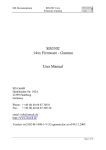
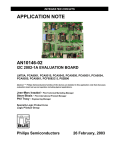
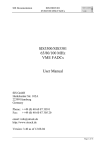
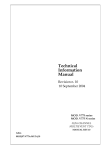

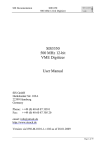
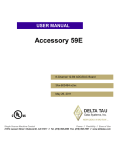
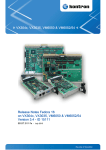
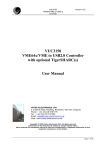
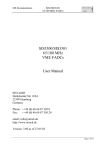
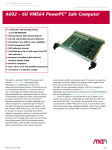
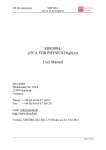
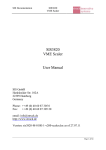
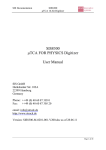
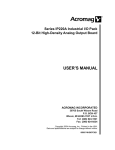

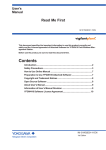
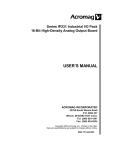
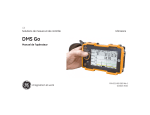
![[DRAFT] DEMO908JL16 User`s Manual](http://vs1.manualzilla.com/store/data/005639706_1-2a84cd2ce2f0b318fdb7aae7896f2a79-150x150.png)
